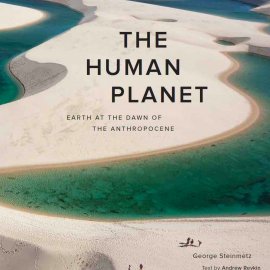The Human Planet
-
English
-
ListenPause
[intro music]
Welcome to World Ocean Radio…
I’m Peter Neill, Director of the World Ocean Observatory.
The Human Planet: Earth at the Dawn of the Anthropocene is a collection of astonishing images of our planet from above, taken by photographer, George Steinmetz, with essays and captions by journalist, teacher, and environmental advocate Andrew Revkin, released in April by art publisher, Harry Abrams, New York. You must discover this book for yourself at your local independent bookstore. I cannot show you the pictures, but I can quote and paraphrase briefly from the text.
The primary, strategic characteristic of Steinmetz’s photographs, Revkin writes in his Introduction, is: “vantage point… the overview effect (that) describes a special sense of awe and deep respect for our planet experienced by astronauts as they have observed Earth first from orbit and then from the moon. That feeling of reverence derives mainly from how Earth’s expanse of blue, green, and white glows, in miraculous, sobering contrast, against the blackness and vacuum of space.” In the chapter, Our Dynamic Earth, Revkin describes: “the face of the planet (that) still holds vestiges of many early chapters, from craters formed by meteorite collisions to ancient hulks of 1.7-billion-year-old rock that rise like the rusting superstructures of time- worn battleships from South America’s seas of forests and savannas.
Landmarks that we take for granted as static geographic or ecological features are newborn on planetary timescales. Their stories are also extraordinarily interconnected, with many of today’s deserts formed of sand transported by long-vanished rivers. And that sediment is still in motion. Scientists recently found that, over millions of years, iron-rich dust blown west from the vast Sahara Desert acted as fertilizer for the marine organisms that built the white calcium carbonate Bahama Banks on which the islands of that name sit today. When that African dust is flowing west a mile or two high over the Atlantic, it can disrupt hurricanes before they grow to threaten the Caribbean; some of this dust flows on from its sere source to fertilize the humid forests of the Amazon basin thousands of miles away.”
In the next chapter, Harvesting the Biosphere, Revkin writes:
“In the warm interval since then, something in the human story profoundly changed. The domestication and spread of rice and millet starting ten thousand to seven thousand years ago, along with early irrigation canals, waves of deforestation and other landscape changes, and the spread of our livestock, left a growing human mark. Then came a cascade of innovations in mining and metalworking, forges and furnaces, machinery and weaponry, wind power and waterpower. Seas were conquered. Peoples were conquered. Some species were hunted to the vanishing point, while invasive hangers-on [like rats] spread with us, amplifying ecological disruption.”
And finally, in the last chapter, The Human Footprint, he concludes:
“Humanity is rapidly becoming an urban species. If cities, throughout human history a distinguishing mark of the human footprint on Earth, are designed well, ongoing urbanization can be a powerful driver of sustainable development. If urban influxes result in the kind of suburban sprawl that was typical in the mid-twentieth century, cities will remain part of the problem, not a path to a balanced relationship between people and the planet.”
Revkin offers persuasive argument, but Steinmetz provides the evocative power, through images of seaweed islands and sand dunes, coral reefs and waves, wind towers, fishing fleets, and floating cities, that by their inclusive distance literally shock our emotions , by the hand of Nature and the aspirations of civilization. This book is filled with contained revelation and emotion; it takes the slow, meditative turning of the pages to release this power into our selves, one stunning photograph at a time. It’s all there for the seeing.
We will discuss these issues, and more, in future editions of World Ocean Radio.
[outro music]
This week on World Ocean Radio we review a new book by photographer George Steinmetz with essays by Andrew Revkin. "The Human Planet: Earth at the Dawn of the Anthropocene" is a collection of stunning photographs of our planet taken from above. The photos are evocative, powerful, emotional and stunning encapsulations of Nature and, for better and for ill, the aspirations of civilization. Published by Harry N. Abrams, April 7, 2020. Available at your local bookseller.
About World Ocean Radio
A weekly 5-minute podcast covering a broad spectrum of ocean issues from science and education to advocacy and exemplary projects. World Ocean Radio, a project of the World Ocean Observatory is available for syndicated use at no cost by college and community radio stations worldwide. Contact director@thew2o.net if you are interested in becoming an affiliate or know of a radio station that should be broadcasting these episodes each week.
Credit
"The Human Planet: Earth at the Dawn of the Anthropocene" by George Steinmetz with essays by Andrew Revkin
- Login to post comments



